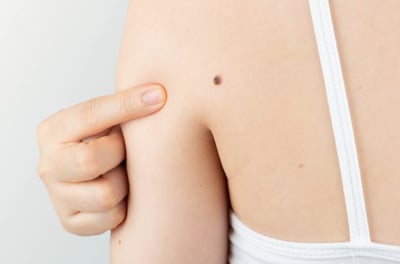
Are you willing to gamble with your skin health? If you are currently skipping the monthly self-skin check and avoiding your yearly skin cancer screening then you are officially a gambler.
Skin cancer is the most common cancer in the United States, with 1 in 5 Americans developing it in their lifetime. Regular self-skin checks and a yearly skin cancer screening by a board-certified dermatologist are crucial to find the cancer early. According to American Cancer Society research, if melanoma is caught in stage one, the 5 year survival rate is 97%. Late detection survival rates can be as low at 15%.
How to Perform a Self-Skin Check
If you haven’t been performing a monthly self-skin check it’s time to get started. Many people say “skin cancer would never happen to me”, but it’s important to remember that skin cancer does not discriminate by age, gender or ethnicity.
According to Peter Katz, board-certified dermatologist with Forefront Dermatology, “as a dermatologist, when we educate our patients on examining their own skin, we commonly refer them to the ABCDE’s. While examining your skin, look for any spots that show Asymmetry, have an irregular Border, vary in Color and have a Diameter that is wider than a pencil eraser. Skin cancer can occur in a variety of colors including brown, black, dull red, or blue and may be flat or raised. It is also important to monitor skin lesions over time to determine if they have Evolved or changed. You know your skin better than anyone else so you will be the first to notice if a spot is new or has changed.”
What to Expect During a Skin Cancer Screening
Not knowing what occurs in a skin screening can be a bit unnerving to a first timer. Dr. Katz helps break the experience down for us:
A typical skin cancer screening is a simple, 10 minute appointment where a board-certified dermatologist examines your body looking for any areas of concern. The screening starts out with you changing into the hospital-style gown we all know and love. Before the skin exam, your dermatologist will ask if you have any areas of concern. Now is not the time to be shy, point out any areas that you may have noticed changes in. While examining your skin, your dermatologist may use a special magnifying glass with a light—called a dermatoscope—to examine certain suspicious spots more closely. If a suspicious lesion is identified, you may need a biopsy.
A biopsy is a quick, simple procedure that helps diagnose the condition. A local anesthetic is applied and a small tissue sample is taken from the suspicious area. The sample is then sent to a pathology lab where results are determined. If the biopsy reveals skin cancer, the remainder of the growth will be removed at a later date.
Be Proactive
Remember, early detection saves lives and a simple monthly self-skin check and yearly in-office skin screening with a dermatologist can truly mean the difference between life and death. To find the Forefront dermatologist nearest you and schedule your annual screening, visit the locations page today.





